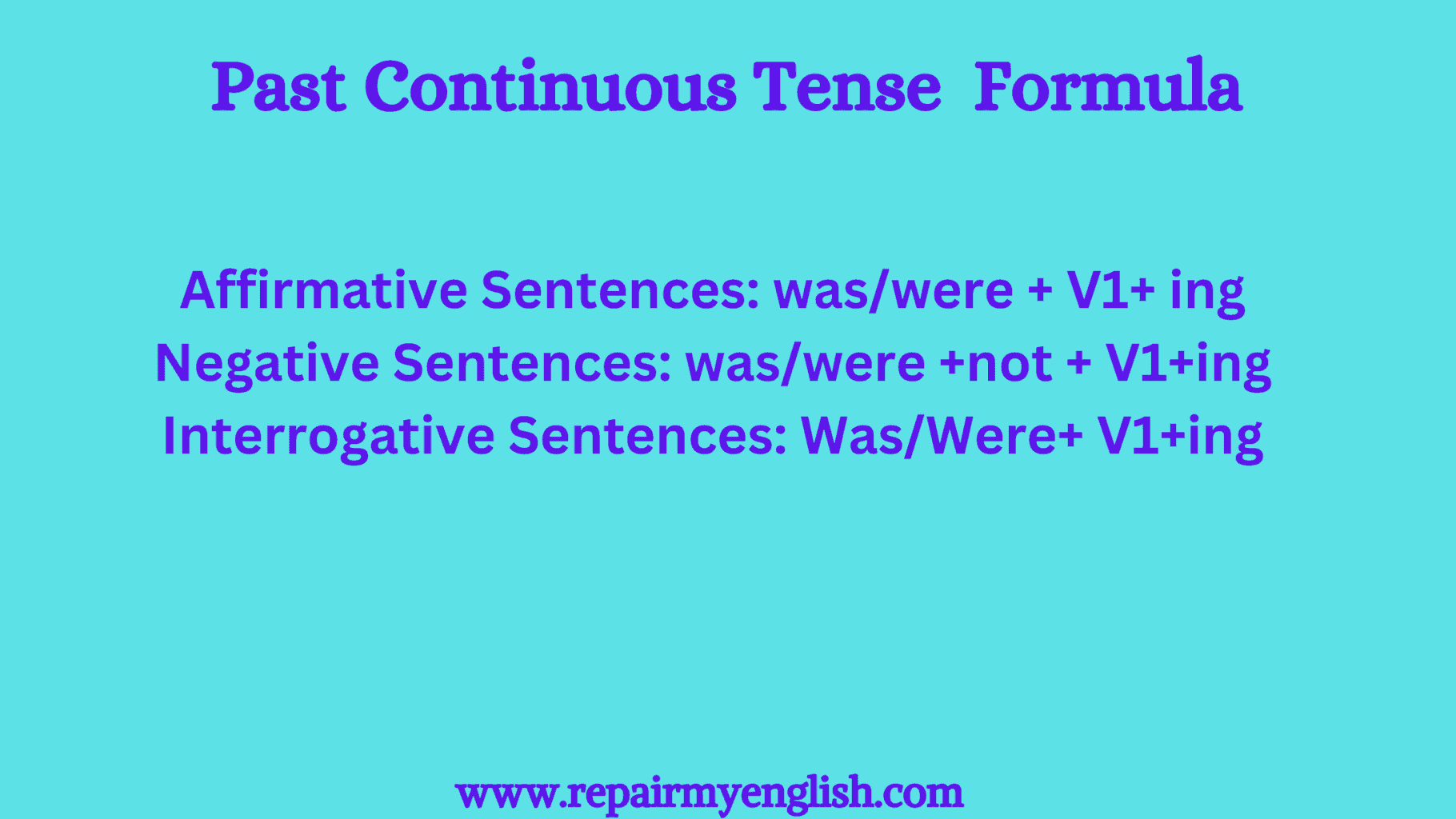Past Continuous Tense Rule: was / were + V1 + ing
Past Continuous Tense Definition:
The Past Continuous tense, also known as the Past Progressive tense, is a grammatical structure used to describe actions or events that were ongoing or in progress at a specific point in the Past. This tense is formed by combining the past tense of the auxiliary verb “to be” (was/were) with the present participle (base form + -ing) of the main verb.
Past Continuous Tense Formula:

Let’s discuss how Past Continuous Tense is used with First Person, Second Person & Third Person.
| First-person singular | I |
| I + was + 1st form of the verb + ing | I was watching the movie. |
| Second-person singular | You |
| You + were + 1st form of the verb + ing | You were watching the movie. |
| Third-person singular | He / She / It |
| He + was + 1st form of the verb + ing | He was watching the movie. |
| She + was + 1st form of the verb + ing | She was watching the movie. |
| First-person plural | We |
| We + were + 1st form of the verb + ing | We were watching the movie. |
| Second-person plural | You |
| You + were + 1st form of the verb + ing | You were watching the movie. |
| Third-person plural | They |
| They + were + 1st form of the verb + ing | They were watching the movie. |
Let’s discuss the usage of Past Continuous Tense:
The Past Continuous tense is used to express that an action was happening in the Past, either for a specific duration or at the moment another action occurred. It’s often used to set the scene or provide context for another activity.
Past Continuous Tense Example Sentences:
- She was writing articles for different magazines.
- My friends were playing basketball in the ground.
- His mother was listening to religious songs last night.
- We were watching a movie in the theatre last night.
- They were studying for their exams all afternoon.
- While I was cooking dinner, my friends were playing board games.
- She was reading a book while her brother was playing the guitar.
Past Continuous Tense Negative Example Sentences:
Rule: Subject + was / were + not + V1 + ing
- Affirmative: She was writing articles for different magazines.
- Negative: She was not writing articles for different magazines.
- Affirmative: My friends were playing basketball in the ground.
- Negative: My friends were not playing basketball in the ground.
- Affirmative: His mother was listening to religious songs last night.
- Negative: His mother was not listening to religious songs last night.
- Affirmative: The author was writing a mystery novel.
- Negative: The author was not writing a mystery novel.
- Affirmative: We were watching a movie in the theatre last night.
- Negative: We were not watching a movie in the theatre last night.
Past Continuous Tense Interrogative Example Sentences:
- Affirmative: She was writing articles for different magazines.
- Negative: She was not writing articles for different magazines.
- Interrogative: Was she writing articles for different magazines?
- Affirmative: My friends were playing basketball in the ground.
- Negative: My friends were not playing basketball in the ground.
- Interrogative: Were my friends playing basketball in the ground?Affirmative: His mother was listening to religious songs last night.
- Negative: His mother was not listening to religious songs last night.
- Interrogative: Was his mother listening to religious songs last night?Affirmative: The author was writing a mystery novel.
- Negative: The author was not writing a mystery novel.
- Interrogative: Was the author writing a mystery novel?Affirmative: We were watching a movie in the theatre last night.
- Negative: We were not watching a movie in the theatre last night.
- Interrogative: Were we watching a movie in the theatre last night?
Past Continuous Tense Usage:
Past continuous tense can also be used when two actions were happening at the same time in the Past:
Examples:
Siddharth was painting while Manisha was watching him.
Gaurav was playing the guitar while Annie was singing on stage.
Next:
Past Continuous + Past Simple
Past Continuous Tense is generally used with the Simple Past tense. It is used to denote a long action, while Simple Past Tense is used to denote a short action in the middle of the long action.
When or while can be used to connect these two actions:
Examples:
When my mother entered the room, I was playing a video game.
1. Long action: playing video game (Past Continuous)
2. Short action: entered (Simple Past)
Past Continuous Tense Example Sentences:
- My father was reading a book when I reached home.
- The hero in the movie jumped off the train while it was moving.
- Her sister heard that the child was crying.
- We were having lunch when the courier delivery boy came.
We use:
when + short action (Past Simple)
while + long action (Past Continuous)
While vs. When
Clauses are groups of words that have meaning but are generally incomplete sentences. Some clauses start with the word “when,” such as “when he called” or “when you reached.” Other clauses begin with “while,” such as “while she was reading” and “while he was moving.”
Talking about things in the Past:
“When” is generally followed by the Simple Past Tense
“While” is usually followed by Past Continuous Tense
The word “while” conveys the sense of “during that time.”
Read the following examples as they have similar meanings, but they emphasize different parts of the sentence:
Examples of “When”
- We were having a party when my neighbour called.
- Students were performing stand-up comedy when the chief guest arrived.
- The marriage ceremony was going on when everyone heard a loud explosion.
- I was shivering when the principal announced the result of the competition.
Examples of “While”
- While we were decorating the room, the guests arrived.
- While Rohit was traveling on the bus, someone stole his purse.
- While the Principal was announcing the results of the competition, the audience got attentive.
- While we were shopping in the mall, the salesman fainted.
Conclusion:
The Past Continuous tense is essential in English grammar for describing actions that were ongoing in the Past. It helps provide a vivid picture of a specific moment in the Past when an action was in progress. This tense is particularly useful for storytelling and explaining simultaneous or interrupted actions. By mastering the Past Continuous tense, you can accurately convey the dynamic nature of past events in your writing and speech.
For related topics Visit our Grammar Page.
